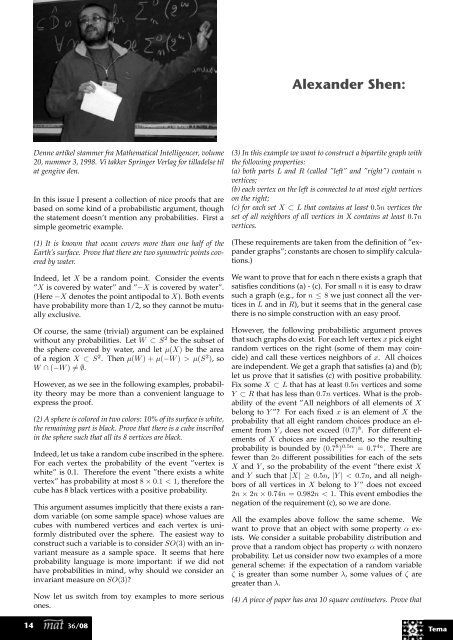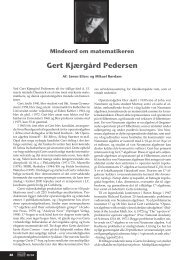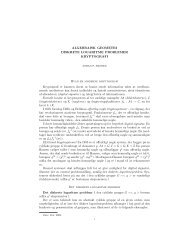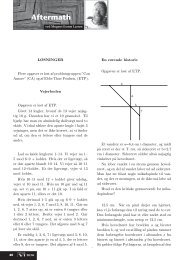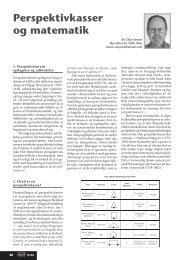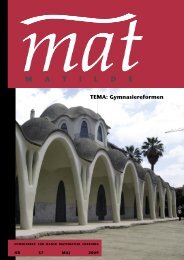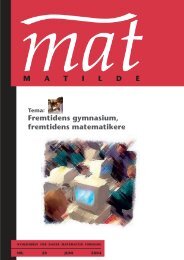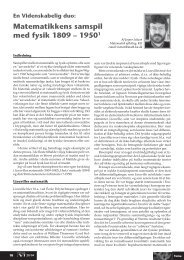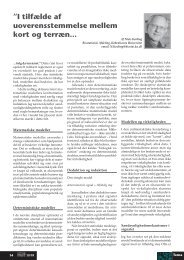Tema: Rekreativ matematik - Matilde - Dansk Matematisk Forening
Tema: Rekreativ matematik - Matilde - Dansk Matematisk Forening
Tema: Rekreativ matematik - Matilde - Dansk Matematisk Forening
Create successful ePaper yourself
Turn your PDF publications into a flip-book with our unique Google optimized e-Paper software.
Denne artikel stammer fra Mathematical Intelligencer, volume<br />
20, nummer 3, 1998. Vi takker Springer Verlag for tilladelse til<br />
at gengive den.<br />
In this issue I present a collection of nice proofs that are<br />
based on some kind of a probabilistic argument, though<br />
the statement doesn’t mention any probabilities. First a<br />
simple geometric example.<br />
(1) It is known that ocean covers more than one half of the<br />
Earth’s surface. Prove that there are two symmetric points covered<br />
by water.<br />
Indeed, let X be a random point. Consider the events<br />
”X is covered by water” and ”−X is covered by water”.<br />
(Here −X denotes the point antipodal to X). Both events<br />
have probability more than 1/2, so they cannot be mutually<br />
exclusive.<br />
Of course, the same (trivial) argument can be explained<br />
without any probabilities. Let W ⊂ S 2 be the subset of<br />
the sphere covered by water, and let µ(X) be the area<br />
of a region X ⊂ S 2 . Then µ(W ) + µ(−W ) > µ(S 2 ), so<br />
W ∩ (−W ) �= ∅.<br />
However, as we see in the following examples, probability<br />
theory may be more than a convenient language to<br />
express the proof.<br />
(2) A sphere is colored in two colors: 10% of its surface is white,<br />
the remaining part is black. Prove that there is a cube inscribed<br />
in the sphere such that all its 8 vertices are black.<br />
Indeed, let us take a random cube inscribed in the sphere.<br />
For each vertex the probability of the event ”vertex is<br />
white” is 0.1. Therefore the event ”there exists a white<br />
vertex” has probability at most 8 × 0.1 < 1, therefore the<br />
cube has 8 black vertices with a positive probability.<br />
This argument assumes implicitly that there exists a random<br />
variable (on some sample space) whose values are<br />
cubes with numbered vertices and each vertex is uniformly<br />
distributed over the sphere. The easiest way to<br />
construct such a variable is to consider SO(3) with an invariant<br />
measure as a sample space. It seems that here<br />
probability language is more important: if we did not<br />
have probabilities in mind, why should we consider an<br />
invariant measure on SO(3)?<br />
Now let us switch from toy examples to more serious<br />
ones.<br />
14 36/08<br />
Probabilistic proofs<br />
Alexander Shen<br />
1<br />
Alexander Shen:<br />
(3) In this example we want to construct a bipartite graph with<br />
the following properties:<br />
(a) both parts L and R (called ”left” and ”right”) contain n<br />
vertices;<br />
(b) each vertex on the left is connected to at most eight vertices<br />
on the right;<br />
(c) for each set X ⊂ L that contains at least 0.5n vertices the<br />
set of all neighbors of all vertices in X contains at least 0.7n<br />
vertices.<br />
(These requirements are taken from the definition of ”expander<br />
graphs”; constants are chosen to simplify calculations.)<br />
We want to prove that for each n there exists a graph that<br />
satisfies conditions (a) - (c). For small n it is easy to draw<br />
such a graph (e.g., for n ≤ 8 we just connect all the vertices<br />
in L and in R), but it seems that in the general case<br />
there is no simple construction with an easy proof.<br />
However, the following probabilistic argument proves<br />
that such graphs do exist. For each left vertex x pick eight<br />
random vertices on the right (some of them may coincide)<br />
and call these vertices neighbors of x. All choices<br />
are independent. We get a graph that satisfies (a) and (b);<br />
let us prove that it satisfies (c) with positive probability.<br />
Fix some X ⊂ L that has at least 0.5n vertices and some<br />
Y ⊂ R that has less than 0.7n vertices. What is the probability<br />
of the event ”All neighbors of all elements of X<br />
belong to Y ”? For each fixed x is an element of X the<br />
probability that all eight random choices produce an element<br />
from Y , does not exceed (0.7) 8 . For different elements<br />
of X choices are independent, so the resulting<br />
probability is bounded by (0.7 8 ) 0.5n = 0.7 4n . There are<br />
fewer than 2n different possibilities for each of the sets<br />
X and Y , so the probability of the event ”there exist X<br />
and Y such that |X| ≥ 0.5n, |Y | < 0.7n, and all neighbors<br />
of all vertices in X belong to Y ” does not exceed<br />
2n × 2n × 0.74n = 0.982n < 1. This event embodies the<br />
negation of the requirement (c), so we are done.<br />
All the examples above follow the same scheme. We<br />
want to prove that an object with some property α exists.<br />
We consider a suitable probability distribution and<br />
prove that a random object has property α with nonzero<br />
probability. Let us consider now two examples of a more<br />
general scheme: if the expectation of a random variable<br />
ζ is greater than some number λ, some values of ζ are<br />
greater than λ.<br />
(4) A piece of paper has area 10 square centimeters. Prove that<br />
<strong>Tema</strong>


